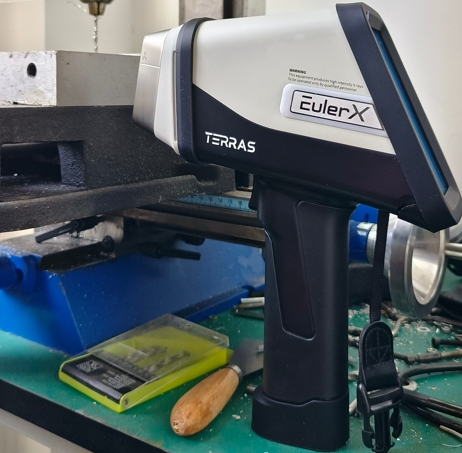
Alloy
A high-tech enterprise focusing on the development and application of X-ray technology products, committed to becoming a leading supplier of X-ray industrial testing solutions.
How Hand Held Metal Detector Manufacturers Are Shaping the Future of Detection Technology
buildings to schools and public events, the need for efficient and reliable detection systems has never been greater. Among the most ubiquitous tools in this mission are hand-held metal detectors, devices that have become indispensable for security personnel across a wide array of industries. But as security threats become more complex, so too must the technology that guards against them. Hand-held metal detector manufacturers are at the forefront of shaping the future of detection technology, driving innovations that are making detection systems more precise, accessible, and user-friendly than ever before.

Terras EulerX900 Handheld Alloy Analyzer
The Evolution of Hand-Held Metal Detectors
Historically, hand-held metal detectors were primarily used for security screening in places like airports or courthouses, where preventing the introduction of weapons or dangerous items was critical. Early models were relatively simple, relying on electromagnetic fields to detect metals. These detectors worked by detecting changes in the magnetic field caused by the presence of metal objects. While they were effective for basic security screening, they were often heavy, clunky, and prone to false alarms.
Over the years, however, hand-held metal detectors have undergone significant advancements. Manufacturers have incorporated more sophisticated technologies, improving sensitivity, discrimination, and ease of use. For instance, modern hand-held detectors utilize pulse induction (PI) technology, which offers superior detection depth and reduces the risk of false positives. Additionally, manufacturers are now developing multi-frequency systems that can detect a broader range of metals, improving accuracy in a variety of settings.
Cutting-Edge Features That Are Redefining Metal Detection
The future of hand-held metal detectors is characterized by several key advancements that are poised to revolutionize the industry. Some of these innovations include:
1. Enhanced Sensitivity and Precision
Modern hand-held metal detectors are becoming increasingly sensitive to smaller objects and materials. While older models would only detect larger, ferrous metals, today’s detectors can pinpoint non-ferrous metals such as gold, silver, and aluminum with incredible precision. Manufacturers are leveraging advanced sensor technologies, such as inductive coils and advanced signal processing algorithms, to detect even the tiniest of metal objects, allowing for highly accurate security screenings.
2. Wireless Connectivity
As wireless technology becomes more integrated into everyday life, manufacturers are incorporating Bluetooth and Wi-Fi capabilities into hand-held metal detectors. This allows security personnel to connect their devices to central monitoring systems or smartphones for real-time alerts and data sharing. This integration not only enhances communication but also enables security teams to monitor multiple detection points from a single location, increasing efficiency and reducing response times.
3. Ergonomic and User-Friendly Designs
As metal detectors become more sophisticated, manufacturers are focusing on enhancing the user experience. Devices are now lighter, more ergonomic, and designed for prolonged use without causing fatigue. A more intuitive interface, with features like vibration alerts or LED displays, makes the detectors easier to operate, even for individuals without specialized training. This user-centric design ensures that security personnel can focus on the task at hand without being distracted by complicated technology.
4. Environmental Adaptability
Many industries are expanding the use of hand-held metal detectors beyond traditional security applications. For example, in construction, archaeology, and even environmental monitoring, detecting metallic objects buried underground or in remote locations is critical. Manufacturers are developing detectors that are more adaptable to harsh environments, such as underwater or extreme temperatures. These rugged detectors can withstand dust, moisture, and high-impact situations, providing reliable performance in diverse conditions.
5. AI and Machine Learning Integration
The integration of artificial intelligence (AI) and machine learning into metal detection technology is paving the way for highly intelligent systems that can learn and adapt to their surroundings. AI algorithms are capable of filtering out irrelevant signals, thus minimizing false alarms and improving the accuracy of detection. Over time, these systems can learn from environmental factors, adapting to specific types of metal and detecting them with greater precision.
6. Energy Efficiency and Sustainability
As global awareness of sustainability grows, manufacturers are also innovating with energy-efficient designs that reduce the environmental impact of these devices. Advanced power management systems are being incorporated to extend battery life, enabling detectors to operate for longer periods without needing frequent recharges. Additionally, the use of more eco-friendly materials and recycling-friendly designs ensures that the technology can meet modern environmental standards.

Terras EulerX900 Handheld Alloy Analyzer
The EulerX 900 series has proved to be an excellent choice for metal analysis in a wide fields, providing fast, accurate results directly to the user. Thanks to its cutting-edge electronics and sophisticated mathematical algorithms, the EulerX 900 series ensures superior measurement quality within seconds. This makes it an ideal tool for inspecting and analyzing incoming materials, finished products, and in-process production parts in a non-destructive manner. Its simplicity of operation allows users to quickly view alloy grade and chemical composition on the touch screen display, achieving laboratory-quality analysis with minimal training and virtually no need for sample preparation, regardless of the sample is shape or size.
In conclusion, hand-held metal detector manufacturers are playing a pivotal role in shaping the future of detection technology. Through innovations in sensitivity, design, connectivity, and AI, they are not only improving security but also paving the way for smarter, more efficient systems that will meet the demands of an increasingly complex world. The next generation of metal detectors promises to be more intelligent, versatile, and effective, providing the safety and peace of mind that society needs in the face of growing security challenges.
Join Us
Subscribe to our email list for updates & promotions.



